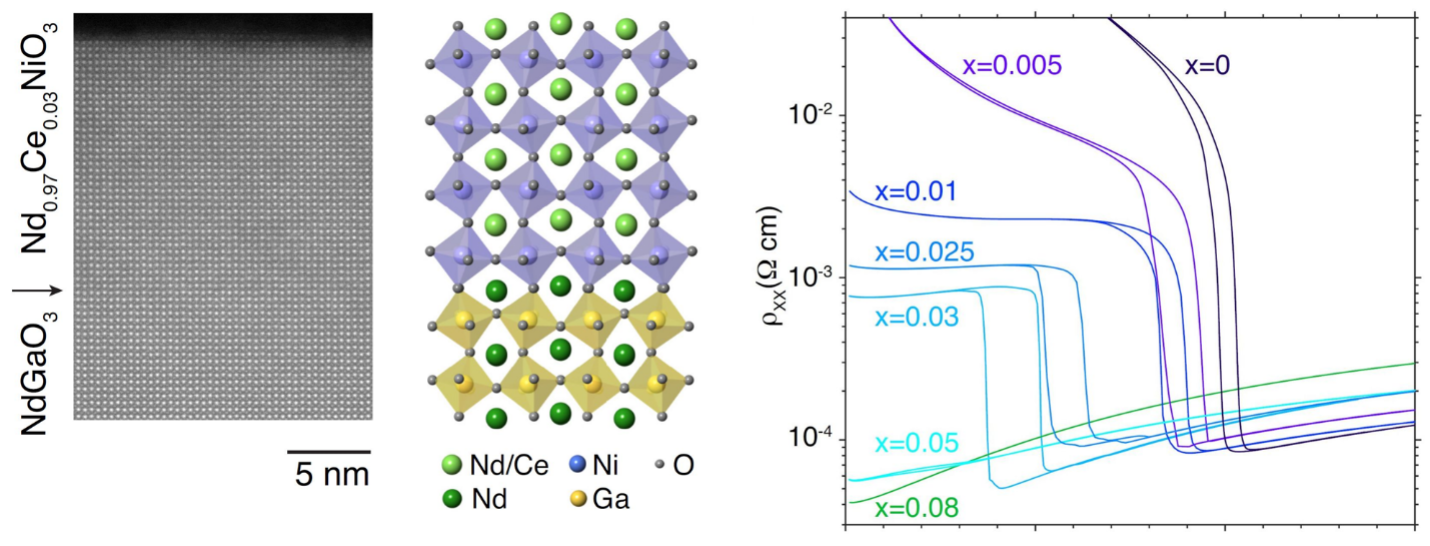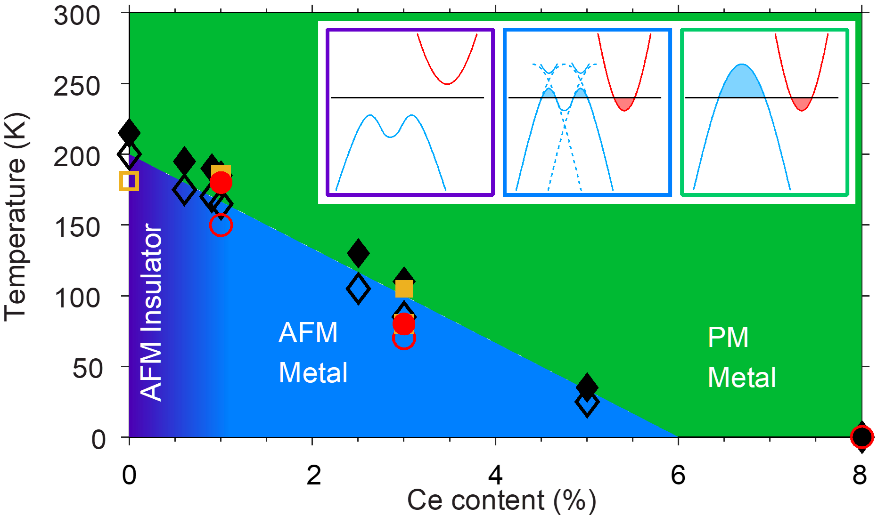PARADIM Highlight #71—External User Project (2023)
Julia A. Mundy, I. El Baggari (Harvard University), Antia S. Botana (Arizona State University), John T. Heron (University of Michigan), A. Lanzara & Luca Moreschini (Advanced Light Source)
A team of experimentalists and theorists connecting at PARADIM have discovered a new antiferromagnetic metal. Their discovery adds to the rich variety of physical properties exhibited by rare-earth nickelates: superconductivity (previously discovered by the core members of this team), metal-insulator transitions, and antiferromagnetic insulators. This latest discovery provides additional insights into the coupling of spin, charge, and lattice degrees of freedom when these elements are combined.

Figure 1: (Left) Atom resolution STEM image of the new material and its interface with the substrate, Structure model shown for comparison. (Right) Resistivity vs. temperature for CexNd1-xNiO3 films synthesized on NdGaO3. Cerium substitution results in qualitative changes in the transport properties of the films. The parent compound NdNiO3 shows a metal-insulator transition at ~200 K with a resistivity increase of about five orders of magnitude. For intermediate cerium doping the resistivity increases but recovers metallic behavior, indicative of a metal-metal transition.

Figure 2: Electronic and magnetic phase diagram extracted in this study on films synthesized on NdGaO3 substrates. AFM and PM refer to antiferromagnetic and paramagnetic, respectively. The symbols indicate electronic transport (◊), RXS (○) and ARPES (□).
The addition of a small concentration of cerium atoms results in low electron doping and preserves the magnetic order on the nickel site while electronically a new metallic phase is induced. ARPES measurements as well as ab initio calculations supported by PARADIM’s Theory Facility confirm the distinctive electronic structure of this new phase. Of potential relevance to spintronics applications, this work demonstrates write-read of the spin structure via a large zero-field planar Hall effect.
The social and knowledge sharing aspects of this discovery reveal the creative power of the PARADIM Platform. At the core of this team lies the strong collaboration between synthesis (Mundy) and theory (Botana), but for this work the team has reconfigured to include a former PARADIM Staff member (Moreschini), a former PARADIM student (El Baggari), and an additional external PARADIM user (Heron).
Long viewed as passive elements, antiferromagnetic materials emerged as promising candidates for spintronic devices due to their insensitivity to external fields and potential for high-speed switching. Recent work in spin orbitronics has identified ways to electrically control and probe the spins in metallic antiferromagnets, with particularly novel mechanisms present in non-collinear or non-centrosymmetric spin structures.
Here a collaborative team of PARADIM users starts with the rare earth nickelate NdNiO3, characterized by both spin and charge ordering, the onset of antiferromagnetic ordering is concomitant with a transition to an insulating state. Upon low electron doping, however, magnetic order on the nickel site is preserved while electronically a new metallic phase is induced. The new phase synthesized might give the opportunity of partially decoupling the lattice and electronic contributions to the famous metal-insulator transition characteristic of the perovskite nickelates. Furthermore, the electron-doped samples display a large zero-field planar Hall effect, and thus offer a new (possibly noncollinear) antiferromagnetic metal of relevance to the spintronics community.
The rare-earth nickelates (RNiO3) exhibit coupling of spin, charge, and lattice degrees of freedom. Except for R=La, all nickelates go through a metal-insulator transition (MIT), with a distortion leading to bond disproportionation, followed by a paramagnetic to noncollinear antiferromagnetic state transition. However, an antiferromagnetic metallic phase has never been observed in this materials family. This work shows that for R=Nd, electron doping by substitution of Ce4+ on the Nd3+ lattice site induces a metal-metal transition (MMT) in which the low temperature noncollinear antiferromagnetic phase is metallic. APRES measurements as well as ab initio calculations supported by PARADIM theory facility confirm the distinctive Fermiology of this new phase. This work expands the already rich phase diagram of rare-earth nickelates offering new insights into the decoupling of coupling of spin, charge, and lattice degrees of freedom. Moreover, this work demonstrates the ability to write to and read from the spin structure via a large zero-field planar Hall effect, with important implications for the spintronics applications.
This work made use of PARADIM’s signature 62-element molecular-beam epitaxy system including its ability to provide an oxidant with high activity (distilled ozone) needed to achieve the Ni3+ in the as-grown films. PARADIM’s differentially pumped sources proved critical for this purpose as the extra pumping provided at the MBE sources allows 10 times higher pressures of distilled ozone to be employed at the substate during growth than standard MBE sources can withstand. This work also made use of PARADIM’s new Thermo Fisher Spectra 300 X-CFEG electron microscope. PARADIM’s Theory and Simulation Facility contributed to advanced ab initio calculations which supported metallicity of the low electron-doped phase and showed group theoretic relationship between different phases.
The work was initiated by researchers from Harvard University and Arizona State University and includes collaborators from PARADIM, the Lawrence Berkeley National Laboratory (LBNL), the University of California at Berkeley, the National Institute of Standards and Technology (NIST), the University of Maryland, Oak Ridge National Lab, and the University of Michigan.
Q. Song, S. Doyle, G.A. Pan, I. El Baggari, D.F. Segedin, D. Córdova Carrizales, J. Nordlander, C. Tzschaschel, J.R. Ehrets, Z. Hasan, H. El-Sherif, J. Krishna, C. Hanson, H. LaBollita, A. Bostwick, C. Jozwiak, E. Rotenberg, S.-Y. Xu, A. Lanzara, A.T. N’Diaye, C.A. Heikes, Y. Liu, H. Paik, C.M. Brooks, B. Pamuk, J.T. Heron, P. Shafer, W.D. Ratcliff, A.S. Botana, L. Moreschini, and J.A. Mundy, "Antiferromagnetic metal phase in an electron-doped rare-earth nickelate," Nat. Phys. 19, 522–528 (2023).
This work is supported by the STC Center for Integrated Quantum Materials, NSF Grant No. DMR-1231319. Materials growth was supported by the National Science Foundation (Platform for the Accelerated Realization, Analysis, and Discovery of Interface Materials (PARADIM)) under Cooperative Agreement No. DMR-203938. This work used resources of the Advanced Light Source, which is a DOE Office of Science User Facility under contract no. DE-AC02-05CH11231. The ARPES work was partially funded by the U.S. Department of Energy, Office of Science, Office of Basic Energy Sciences, Materials Sciences and Engineering Division under Contract No. DE-AC02-05-CH11231 (Ultrafast Materials Program KC2203). A portion of this research used resources at the Spallation Neutron Source (SNS), a DOE Office of Science User Facility operated by the Oak Ridge National Laboratory (ORNL), and resources of the SNS Second Target Station Project. ORNL is managed by UT-Battelle LLC for DOE’s Office of Science, the single largest supporter of basic research in the physical sciences in the United States. This manuscript has been authored by UT-Battelle, LLC, under contract DE-AC05-00OR22725 with the US Department of Energy (DOE). The US government retains and the publisher, by accepting the article for publication, acknowledges that the US government retains a nonexclusive, paid-up, irrevocable, worldwide license to publish or reproduce the published form of this manuscript, or allow others to do so, for US government purposes. DOE will provide public access to these results of federally sponsored research in accordance with the DOE Public Access Plan (http://energy.gov/downloads/doe-public-access-plan). Device fabrication work was performed at Harvard University's Center for Nanoscale Systems (CNS), a member of the National Nanotechnology Coordinated Infrastructure Network (NNCI), supported by the National Science Foundation under NSF Grant No. 1541959. Any mention of commercial products within this paper is for information only; it does not imply recommendation or endorsement by NIST. Work at the NCNR was supported by the Department of Commerce. W. R. acknowledges support from the Department of Commerce. S.D. acknowledges support from the NSF Graduate Research Fellowship Grant No. DGE-1745303. G.A.P. acknowledges support from the Paul & Daisy Soros Fellowship for New Americans and from the NSF Graduate Research Fellowship Grant No. DGE-1745303. J.N. acknowledges support from the Swiss National Science Foundation under Project No. P2EZP2 195686. C.T. acknowledges support from the Swiss National Science Foundation under Project No. P2EZP2 191801. Work in the S.-Y.X. group was supported through NSF Career (Harvard fund 129522) DMR-2143177. A.S.B. acknowledges support from NSF Grant No. DMR-2045826 and the ASU Research Computing Center for HPC resources. J.A.M acknowledges support from the Packard Foundation and Gordon and Betty Moore Foundation's EPiQS Initiative, Grant GBMF6760.







